Samsung Galaxy Note 10 Review
Samsung Galaxy Note 10 Review
Should you buy the smaller Galaxy Note this year?
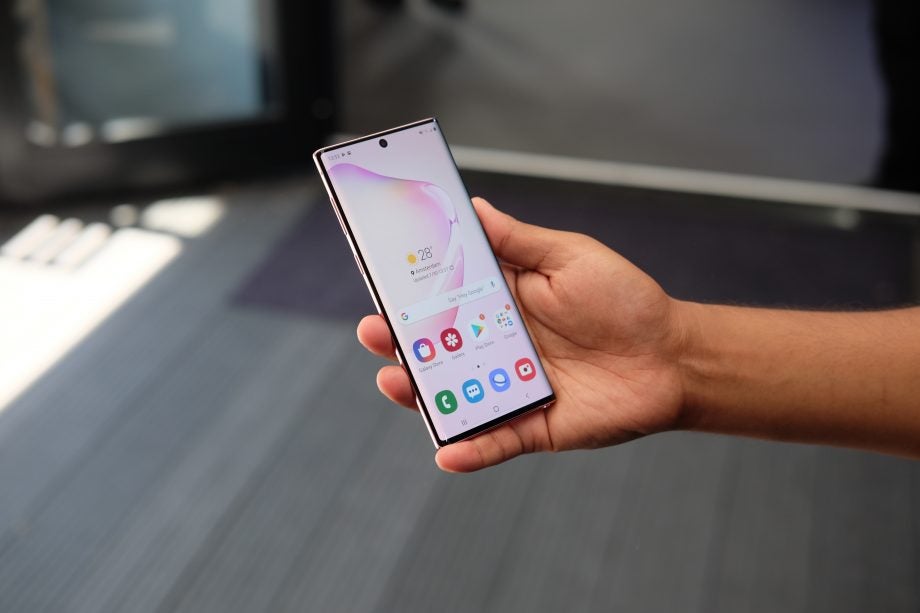
Verdict
This year, probably more than most, the Galaxy Note 10 appears to be a slightly remodelled Galaxy S10, complete with an S Pen. That’s no bad thing – the S10 is one of the best Android phones around – but it would have been nice to see Samsung push forward in areas where the S10 has fallen behind some of the competition; the camera is a good example. The display here is great. The design remains the best of any Android phone, and the functionality of the S Pen offers something you can’t get elsewhere. I also really like its slightly smaller form factor. However, the Plus model’s existence is likely to impact negatively on the Note 10. Samsung appears to be driving you towards purchasing the bigger model by restricting such features as expandable storage, screen resolution and camera quality in the Note 10.
Pros
- Fantastic size for a Note phone
- The S Pen remains great
- Very powerful; Cameras are versatile
Cons
- Battery life isn’t great
- Some missing features such as SD card expandability and quad-HD+ screen
Key Specifications
- Review Price: £869
- 256GB storage, no microSD
- Up to 45W fast charging
- Exynos 9825, 8GB RAM
- 6.3-inch FHD+ display
- No headphone jack
- 3500mAh battery
- IP68 certified
- One UI
The Samsung Galaxy Note 10 isn’t the true update to the Galaxy Note 9 you may have been expecting. This phone feels like a Galaxy S10e version of the Note: a slimmed-down feature set inside a smaller body.
The big shift for this latest generation of Note is that there are now two models, whereas previously there’s only ever been one. The Galaxy Note 10 is the smaller device here, while the Galaxy Note 10 Plus packs the true flagship specs.
For the most part, these two new Note devices share plenty of specs and features, which makes sense. More problematic is the resemblance that both phones bear to Samsung’s Galaxy S10 and S10 Plus, which launched early in 2019. There’s also the rumoured upcoming Samsung Galaxy S20 and Samsung Galaxy S20 Ultra – both of which will likely have better specs.
The Galaxy Note 10 is a decent phone and I appreciate no longer being forced to opt for the biggest screen to experience the benefits the S Pen. However, the fact that there are some key features lacking for the price makes it a harder sell.
Related: Galaxy Note 20 review: hands-on
How much does the Samsung Galaxy Note 10 cost?
The standard Note 10 comes in one configuration that packs 256GB of storage and 8GB of RAM at a price of £869 (or $949, if you’re in the US).
The phone is available now and you can check out our best Note 10 deals page for all the details on how to pick one up.
Display and design
- Two real standouts
On the size scale, the Note series devices have always presented at the larger end. With this year’s two-phone strategy, and the current smartphone trends, things are a little different.
The Note 10’s display at 6.3in is actually smaller than last year’s Note 9, which featured a 6.4in screen. Although not a huge difference, in the hand both handsets feel markedly different, thanks to a new design language on this year’s model.
The display now runs to the edges of the phone’s front, granting it an impressive 90.9% screen-to-body ratio. What’s more, the single Infinity-O hole-punch camera is now centrally aligned at the top of the screen, and therefore less intrusive than the S10’s solo-sensor effort.
Related: iPhone 11 | iPhone 11 Pro
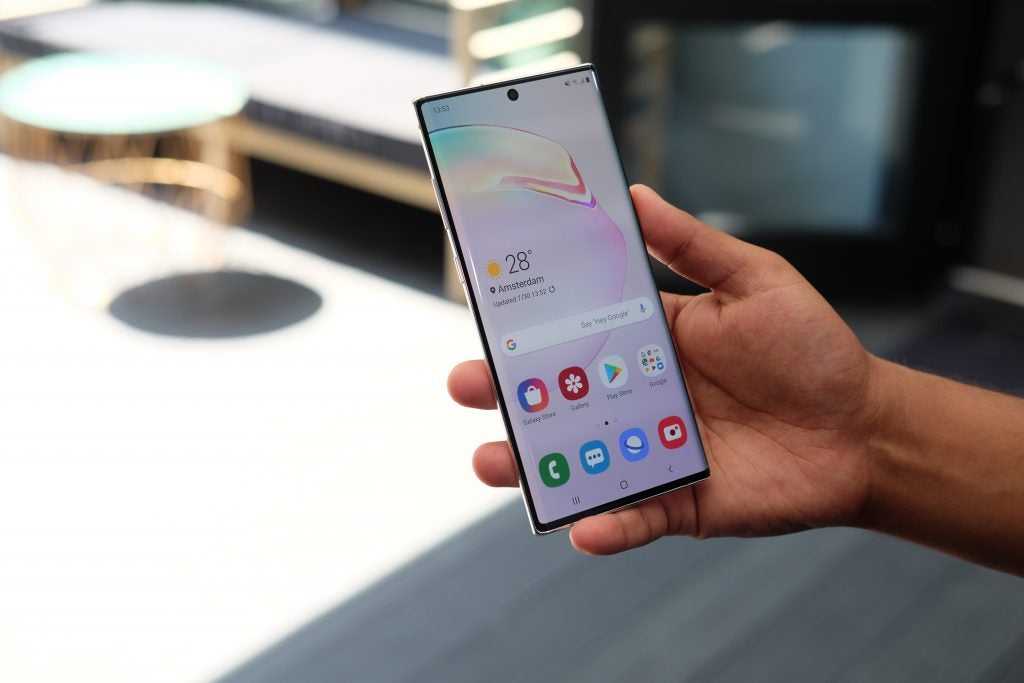
Until Samsung does a OnePlus 7 Pro and fits the front camera into a pop-up mechanism or finds a way of submerging it completely inside the display, this is the best solution.
During the review period I’ve been alternating between using the Black and Aura Glow versions of the Note 10. The Aura Glow is the colour Samsung seems to be pushing more than any other. This is hardly a surprise given it’s easily the most eye-catching of the bunch. Would I buy this one if I were in the market for a phone myself? Probably not. It’s nice, yes, but it’s a little garish and looks better in pictures than after it’s been in your pocket for a few days.
As far as aesthetics go, the display and the glass back curve together to create a more compact feel in the hand than you’d imagine viewing it alone.
The actual panel itself could be seen as a downgrade from the previous model; Samsung has lowered the resolution from the QHD+ panel on the S10 and S10 Plus to the FHD+ of the Galaxy S10e.
Frankly, I think this an odd move. The Note series has always been about having the best of everything, and this move certainly doesn’t fit with that idea. Of course, the screen remains decent, displaying punchy colours and the perfect inky blacks you’d normally associate with OLED panels from Samsung.
The screen also offers support for HDR10+ – a couple of Amazon Prime shows have this – and the Netflix app has HDR support. Watching videos on this display is great, especially now with the smaller notch, which doesn’t obstruct your viewing as much.
Note that there are a number of reasons that lowering the resolution would make sense for Samsung. The most obvious is that it creates an incentive for buyers to plump for the pricier Plus model.
There’s also the slight issue of the small battery on offer here (3500mAh versus 4300mAh on the Note 9); the lower-resolution display requires less power, therefore helping to eke out more battery life. However, as you’ll see in the Battery section below, endurance isn’t really a strong point of this phone anyway.
My biggest disappointment about the Note 10’s display is Samsung’s decision not to up the refresh rate to 90Hz, as seen in the OnePlus 7 Pro, instead keeping it at the usual 60Hz. I love the smoothness of the 7 Pro’s display. Had Samsung opted to do the same, it would have made the Note stand out. Especially now that there are rumours circulating that the upcoming Pixel 4 will have a 90Hz display too.
- Read our hands-on Samsung Galaxy Note 10 Plus review
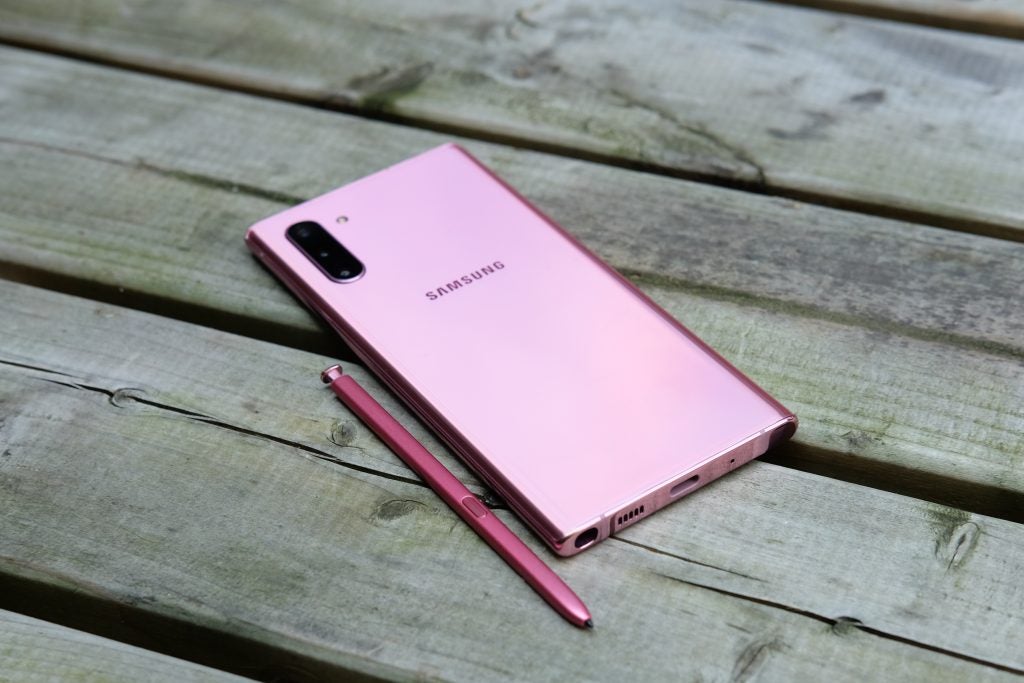
The Note 10 also comes in a nice pink colour
Inside the screen you’ll find the ultrasonic fingerprint sensor, which is the main method of unlocking the Note 10. I’m still not convinced this is much of an improvement over the physical sensor on the old Note phones, since it requires quite a firm press and often doesn’t register my digit.
S Pen
- The biggest trick is the handy stylus
Nestled next to the USB-C port on the phone’s bottom is the S Pen – the hidden trick of the Note 10 and a staple of the series. It’s also the single feature that sets the device apart from Galaxy S10 series.
The S Pen is supremely responsive when writing or drawing, and it retains all the handy features we’ve seen before. This includes screen-off notes, which allow you to jot down a few points without having to unlock the phone.
Very little has really changed with the S Pen, and considering there’s virtually no competition, there’s nothing pushing Samsung forward. Much of what is new here is software-based (save for a new gyroscope and accelerometer), including gestures you can perform with the S Pen to snap a photo or zoom in.
These “Air Gestures” are finicky and gimmicky at best. The idea is that you hold the S Pen away from the phone and move it around to zoom in with the camera, for instance. They do work, eventually, but I’m not sure whether anyone will use them consistently.
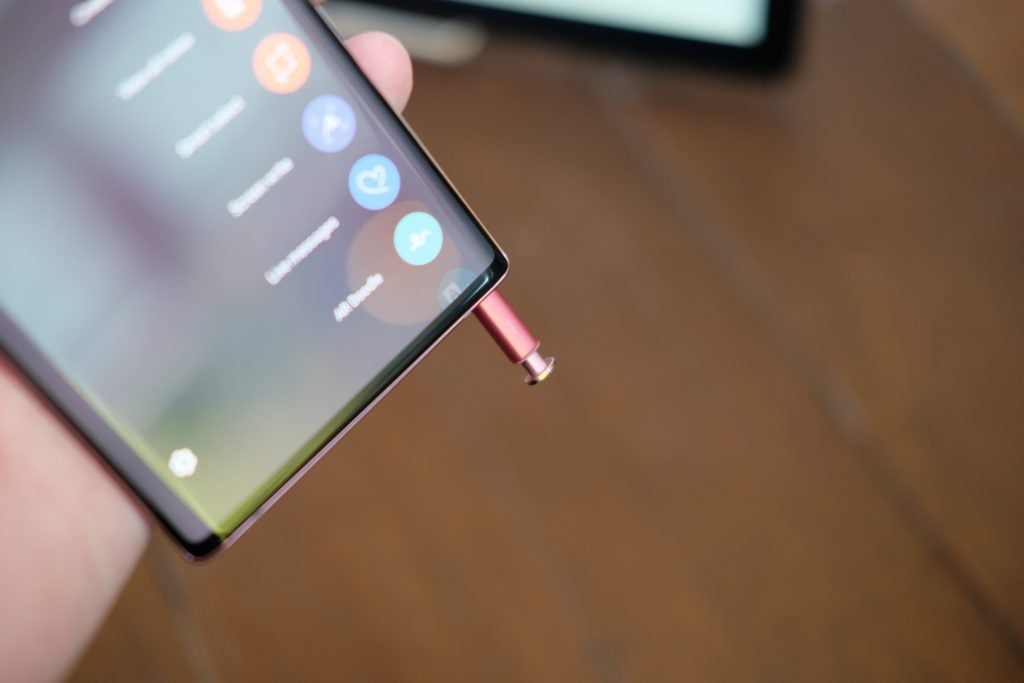
Samsung said it has also increased battery life to 10 hours – although I wouldn’t be able to provide you with an example of a time my S Pen has died. It always charges back up when you return it to its home, anyway.
There are a couple of enhancements to the note-taking app, too, with handwriting optical character recognition (OCR) being the biggest. This is fantastic and makes the S Pen a modern notebook. OCR lets you search through your handwritten notes with text, letting you easily find what you’re looking for without manually looking over each page.
MicroSD and headphone jack
- Two big Note features have been removed
We all knew it was coming, but with the Galaxy Note 10 Samsung has finally killed the headphone jack. Many have probably come to terms with the death of this port by now – it’s been nearly three years since Apple first made the move – but it nevertheless removes another point of distinction for the Note series.
To make up for this loss Samsung has bundled a pair of USB-C AKG in-ear buds in the box. These sound fine and are an improvement over the EarPods that come bundled with the iPhone.
What you won’t find in the box is a 3.5mm to USB-C adapter – if you want to use your own buds with this phone, you’ll need to buy one separately. I tried a couple of USB-C headphone dongles I had lying around and they all worked fine.
Another omission is the microSD card slot, removing any form of expandability from the Note 10. Want user-configurable storage? The Note 10 Plus is for you. Like lowering the screen’s resolution, this feels like an obvious push to get people to pay more for a feature we’ve come to expect on Samsung’s phones.
I’d be far more critical of the lack of expandable storage if the default storage wasn’t 256GB. Considering Apple continues to push people to buy £1000/$1000 iPhones with a mere 64GB storage and no expandability, I can’t blame Samsung too much.
Performance
- An absolute beast
What powers the Samsung Galaxy Note 10 will vary depending on region. Here in the UK, and other territories including Canada and Asia, the Galaxy Note 10 is powered by the Exynos 9825 – a slightly more efficient version of the S10’s 9820.
If you’re in the US then you have the Snapdragon 855 version, rather than the newer gaming-focused 855 Plus. RAM stands at 8GB and, as already mentioned, storage is at 256GB. Those of you hoping to make use of the vast array of 5G networks in the UK will have to cough up for the pricier 5G version of the Samsung Galaxy Note 10 Plus. There’s no 5G version of the Note 10 available in any region apart from Korea.
After using the European version of the Note 10 for a couple of weeks, it’s safe to say this is a nippy handset. It doesn’t feel any quicker than the S10, and coming from the OnePlus 7 Pro it does seem slower due to the lower refresh display. These are minor niggles, however – although with so many handset feeling super-quick, it’s far more noticeable.
Gaming, on the other hand, is near-perfect. Every title I tried, from intensive games such as Asphalt 9 and PUBG to lighter ones such as Monument Valley 2, worked flawlessly. Loading up a game is still faster on the iPhone XS, but the Note 10 booted everything up quicker than S10.
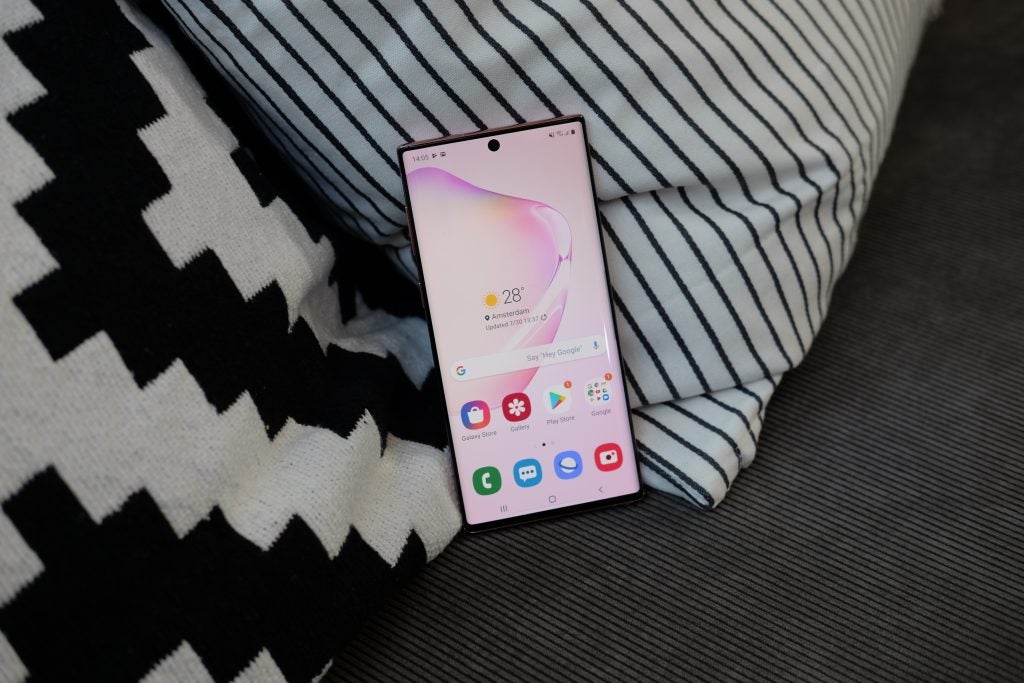
I did notice a few oddities during my time with the Note 10, however. For one, Bluetooth headphones consistently dropped connection. This wasn’t confined to a single pair – I tried some Bose QC35s, AirPods and even Samsung’s own Galaxy Buds, which actually fared better) – but it proved seriously frustrating. I also had issues with USB-C headphones causing third-party music apps such as Audible and Spotify to crash. Hopefully, these issues will be fixed in a software update.
Battery life
- The Note 10’s weakest point
Samsung’s Note phones have had an excellent reputation among Android devices when it comes to endurance. That’s still the case with the Note 10 Plus, just not as much with the smaller Note 10.
The 3500mAh cell that sits in the latter device just isn’t big enough to power everything on offer here and that leads to middling endurance that often struggled to get me through the whole day – not something I expected from a Note phone.
Throughout my time with the Note 10 Plus, the device normally managed between six and seven hours of screen-on time; with the Note 10 that was cut to about four. Still perfectly adequate for most people, but not really what this series of phones is about.
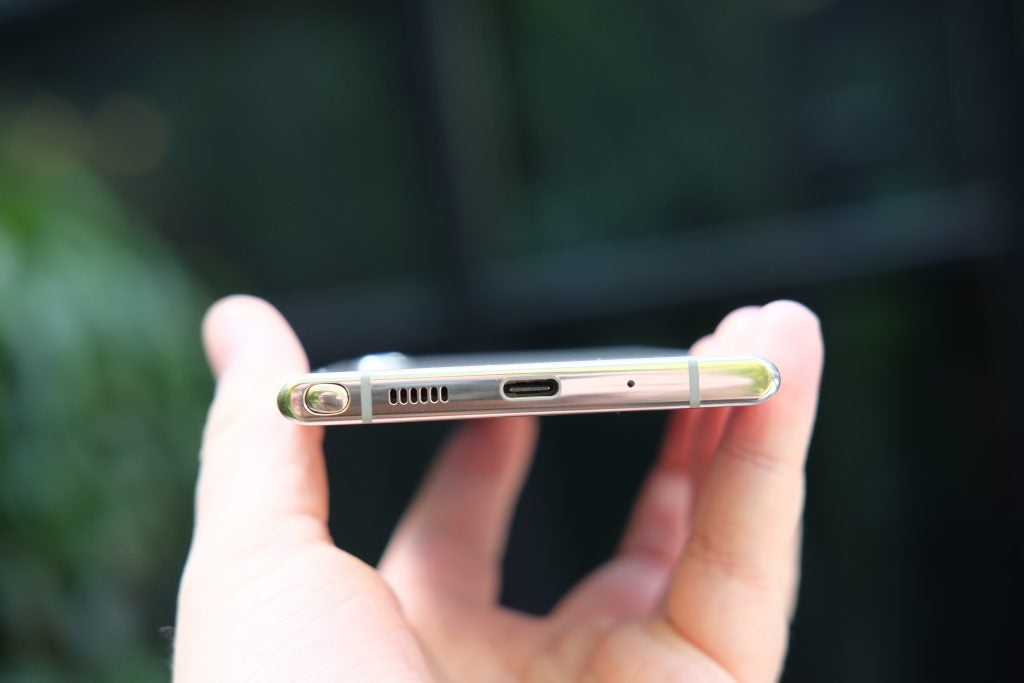
An hour of Netflix streaming consumed 12% and 30 minutes of Asphalt took the battery down another 15%.
At least the device charges relatively quickly when you hit the red, thanks to much-improved super-fast 25W charging. This is done via a new USB-C-toting charger, and you’ll get a full charge in roughly an hour.
There’s 15W wireless charging, too, and the nifty Wireless Powershare feature lets you use the Note’s battery to recharge other Qi devices, such as the company’s Galaxy Buds or the recently launched Galaxy Watch Active 2.
Camera
- Mostly unchanged from the Galaxy S10, it remains a good camera
On the back of the Note you’ll find three cameras: a main 12-megapixel sensor with an aperture that will shift between f/1.5 and f/2.4 depending on the conditions, a 16-megapixel ultra-wide f/2.2 sensor, and a 12-megapixel f/2.1 telephoto camera offering 2x lossless optical zoom.
Both the main and telephoto cameras have OIS (optical image stabilisation) – just as they did on the S10. There are a couple of new AR camera features and you can use the S Pen’s Air Gestures to zoom in and snap a shot without touching the screen. For better or worse, this is mostly the same camera experience you’ll find on the S10 series.
Samsung has consistently offered photo processing that looks pleasing to the eye and is good for social media. Colours have a burst of vividness and saturation that other phones can’t match, and there’s a little extra sharpening added to make everything more detailed. This is the same across all three cameras, and I just admire how it churns out greats shots every time.

The wide camera takes versatile snaps

Night mode turned on

Night mode off

Colours are bright and vivid
It’s also such a good camera app, far more reliable and quicker to navigate than the competition from Huawei and Google. It’s instant when you’re switching between the three sensors or jumping into Portrait mode.
Samsung has added a Night mode to the Note 10 as well. This mode brightens low-light shots, bringing out the light portions and making the whole picture more exposed. It works okay, although I often found that shots taken in this mode were almost too bright. As a result, they could look a little fake. It’s a good job then that the aperture-switching main sensor can take decent snaps in the dark anyway.
More changes come to light when you switch to video. There’s a new mic-zoom feature that will zoom in on the audio you’re recording using beamforming, thus reducing background noise in the process. What’s more, you can add a bokeh effect to videos and photos with “Live Focus”. Around the front, the cutout hides a 10-megapixel single front camera which has a nice wide angle to fit lots in.
Software
- One UI, DeX and lots for gamers
Samsung signalled a huge change in its software with One UI and that remains the basis of the Samsung Galaxy Note 10. One UI’s original purpose was to simplify the often convoluted software found on previous Samsung devices, making everything easier to navigate one-handed in the process.
For the Note 10, Samsung has added a couple of new features based around productivity and gaming.
First is DeX. This is Samsung’s PC interface for its Note series. Until now, it’s only been accessible with a dock that’s sold separately. Now you can plug the Note 10 directly into another computer (Windows or Mac) to access DeX, and Samsung has partnered with Microsoft to make it easier to access your notifications, messages, images and so on via a PC.
While the DeX app is a nice idea, it doesn’t work particularly well. It’s slow and buggy, making any task a bit of a chore. However, it does offer a quick way to move photos from your phone to a computer.
Related: Best gaming phones 2019
In general, gaming modes and gaming phones are becoming more popular, and it appears that Samsung wants a piece of the pie.
Instead of releasing a dedicated gaming device, such as the Asus ROG Phone 2, it has added lots of game-specific features to the Note 10 series. You can link it with a PC, for example, and stream games through the PlayGalaxy app.
Should I buy the Samsung Galaxy Note 10?
This year, probably more than most, the Galaxy Note 10 appears to be a slightly remodelled Galaxy S10, complete with an S Pen.
That’s no bad thing – the S10 is one of the best Android phones around – but it would have been nice to see Samsung push forward in areas where the S10 has fallen behind some of the competition; the camera is a good example.
The display here is great. The design remains the best of any Android phone, and the functionality of the S Pen offers something you can’t get elsewhere. I also really like its slightly smaller form factor.
- What’s the difference between the new Notes? Galaxy Note 10 vs Note 10 Plus
However, the Plus model’s existence is likely to impact negatively on the Note 10. Samsung appears to be driving you towards purchasing the bigger model by restricting such features as expandable storage, screen resolution and camera quality in the Note 10.
How we test phones
We test every mobile phone we review thoroughly. We use industry standard tests to compare features properly and we use the phone as our main device over the review period. We’ll always tell you what we find and we never, ever, accept money to review a product.


